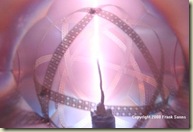 Sometimes, you just have to do for yourself, so if you want nuclear power, you build a reactor. The Wall Street Journal's Sam Schnecter reports on a group of science fiction fans and amateur scientists who are working on home-based fusion reactors:
Sometimes, you just have to do for yourself, so if you want nuclear power, you build a reactor. The Wall Street Journal's Sam Schnecter reports on a group of science fiction fans and amateur scientists who are working on home-based fusion reactors:
Getting into their elite "Neutron Club" requires building a tabletop reactor that successfully fuses hydrogen isotopes and glows like a miniature star. Only 42 have qualified; some have T-shirts that read "Fusion -- been there...done that."
Like many such projects, it has its quixotic side, since fusion works well for, oh, the sun, but practical applications are harder to come by:
But they won't be powering homes anytime soon - for now, fusors use far more energy than they produce. [Fusors are the tabletop reactors.]
For now and likely, for the foreseeable future. But that's not the point. This is something that you do because it can be done, it fascinates you, and into the bargain, it acts as a highly specific secret handshake for those who do it.
While some amateurs, like Mr. [Frank] Sanns, think fusion power holds promise, others are less hopeful. "Basically, it's almost like, over the gates of hell, 'Abandon hope all ye who enter,'" says Richard Hull, who built his first working fusor nearly a decade ago.
We have nothing but admiration for people who do something for the sheer love of it, however arcane that love may be. These guys have a community that supports and nurtures their fusion passion - it's at Fusor.net - and since the WSJ article numbers them at about 100 worldwide, the Internet is the right place for them to found that community. (Though we wouldn't be surprised if they found each other through FidoNet in an earlier age.)
Lots of great detail in the article, so take a read. If fusion interests you, visit Fusor.net. (We think the electricity demands of fusion, not to mention the purchase of stuff like deuterium, might quell our curiosity - you really have to want to do this and commit yourself to it.)
"This is an early un-retouched photo of one configuration of Pillar of Fire. It was put together quickly for visit by Carl Willis. The POF configuration in this case consisted of a normal feedthrough and stalk with a voltage divider on the bottom that goes to ground. This was a neutron producing run." from Fusor.net.
Comments
Fusion Report 13 June 008
It is a fusor type device being tested by the Navy. It uses magnets to overcome some of the Fusor loss problems.
http://www.ktvb.com/news/localnews/stories/ktvbn-aug2208-nuke_plant_suit.1790102.html
BOISE -- The company working to build a nuclear power plant in Elmore County is suing an idaho environmental group over comments made to a KTVB reporter in an interview last week.
Alternate Energy Holdings today filed a defamation lawsuit against the Snake River Alliance.
In the interview, Snake River Alliance spokesperson Andrea Shipley said Alternate Energy Holdings was "scamming Idahoans."
The company alleges that due to the woldwide reach of KTVB and KTVB.COM, the comment was causing them substantial damage.
The Snake River Alliance says neither they nor Andrea Shipley have been formally served in the suit, and they have no comment at this time.